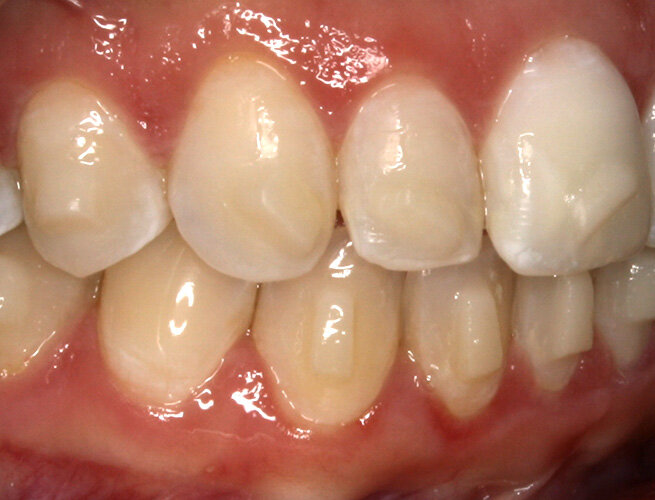Why Do I Need Attachments Glued to My Teeth for Invisalign?
Clear aligners are the rage in orthodontics today. You can’t watch a TV show, view social media, or listen to the radio without being exposed to an advertisement for some type of plastic aligner system that offers you a new smile. The biggest company in this market is Align Technology who produces Invisalign. They have a huge advertising budget and their aligners have become a household name like Kleenex and Band-Aids. New patients come to my office every day asking for me to straighten their teeth with Invisalign because they don’t want anything glued to their teeth. Many are surprised when I explain that although Invisalign doesn’t use brackets and wires, there are still tooth-colored “attachments” that must be glued to the teeth to achieve a successful outcome. What are attachments and why are they necessary?
Aligners move teeth by pushing against them
Plastic aligners use a series of clear plastic shells that are shaped so that they sequentially guide the teeth into their desired positions. Two fundamental principles must be remembered about aligners. First, plastic can only push, it cannot pull. For a tooth to move in any desired direction, there must be a surface against which the aligner can push. Second, for a tooth to remain engaged in the aligner (to “track”), there must be an undercut or purchase point that allows the plastic to grip the tooth. Some teeth have natural undercuts because they are round or bulbous in shape (primarily the back ones). Other teeth are more triangular or pyramidal in shape (the front ones). For all movements except intrusion (pushing the teeth towards the gums), attachments are necessary to create the required pushing surfaces and undercuts. These movements include tipping, rotating, and lengthening the teeth.
Attachments act as handles on the teeth
To create pushing surfaces and undercuts, orthodontists construct “attachments” or bumps on the teeth using tooth-colored composite (the same material used to repair chipped teeth). The size, shape, number, and location of these attachments is determined by the anatomy of the teeth and the desired movements. Although visible up close, most attachments are invisible to the naked eye at normal conversational distances (about 3 feet). Orthodontic attachments provide the same function for clear aligners as brackets do with conventional braces. They are just handles on the teeth. I tell my patients to think of their attachments as the brackets and the plastic aligners as their wires.
Many tooth movements are impossible without attachments
Some patients are adamant that they don’t want to have anything glued to their teeth. Unfortunately, trying to make certain movements without attachments is scientifically impossible. Imagine an upper lateral (second tooth from the center) that needs to be longer to look straight. Without an attachment to provide an undercut, the tooth will remain its original length no matter how well the aligner is designed or worn. Additionally, making the aligners tighter on a tooth in hopes that it will move with the plastic actually causes the opposite effect (the tooth will actually move up rather than down). Think of how a watermelon seed squirts through your fingers when you squeeze it to pick it up. Similarly, if the plastic aligners are programed to tip a pyramidal shaped tooth without an undercut, the tooth will actually slide UP the aligner rather than move with it.
Attachments glued to the teeth are necessary for accurate, predictable orthodontic movements. I wish there was a way to move teeth successfully without them using aligners, but as of 2018 one does not exist. As I mentioned in my blog post about unrealistic expectations, I once had a hair stylist who had a mug on his station that read, “I’m a beautician, not a magician.” I wish orthodontist rhymed with magician…
NOTE: The author, Dr. Greg Jorgensen, is a board-certified orthodontist who is in the private practice of orthodontics in Rio Rancho, New Mexico (a suburb on the Westside of Albuquerque). He was trained at BYU, Washington University in St. Louis, and the University of Iowa in the United States. Dr. Jorgensen’s 25 years of specialty practice and nearly 10,000 finished cases qualify him an expert in two-phase treatment, extraction and non-extraction therapy, functional orthodontics, clear aligners (Invisalign), and multiple bracket systems (including conventional braces, Damon and other self-ligating brackets, Suresmile, and lingual braces). This blog is for informational purposes only and is designed to help consumers understand currently accepted orthodontic concepts. It is not a venue for debating alternative treatment theories. Dr. Jorgensen is licensed to diagnose and treat patients only in the state of New Mexico. He cannot diagnose cases described in comments nor can he select treatment plans for readers. Please understand that because he has tens of thousands of readers each month, IT IS IMPOSSIBLE FOR HIM TO RESPOND TO EVERY QUESTION. Please read all of the comments associated with each article as most of the questions he receives each week have been asked and answered previously. The opinions expressed here are protected by copyright laws and can only be used with written permission from the author.

